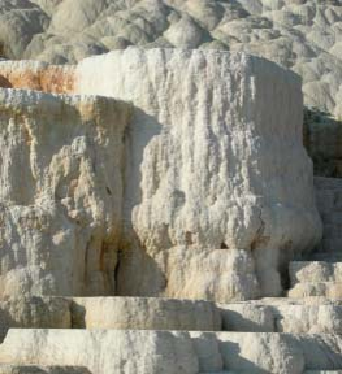Travel Reference
In-Depth Information
Inactive terraces are white; long-inactive ones are various shades of gray. What makes
the springs that build the terraces so unpredictable? The accumulating travertine tends to
clog the plumbing, and varying water supply, chemistry, temperature, and frequent earth-
quakes may also contribute to the changes.
Some Facts and Figures about Mammoth Hot Springs
Every day at Mammoth an estimated 1.4 million gallons (5.3 million L) of water is dis-
charged and about two tons of new travertine are deposited. However, Mammoth is not
the world's largest set of active travertine terraces; a larger one, Pamukkale (ancient Hiera-
polis) in southwestern Turkey, covers several square kilometers, and there may be others.
Besides the large terraces, other types of travertine features at Mammoth are domes
such as Liberty Cap,
fissure ridges
fed by water rising through cracks, and
terracettes,
semi-
circles of travertine at the edges of a hot spring pool.
Palette Spring's terracettes, including one shaped like a tall pulpit (2012)
In over a century of observation, geologists have concluded that the overall thermal
activity has neither declined nor increased. Over time, some hot springs seal themselves
and never reopen, others cease and resume, and new ones appear with no warning. Change
is constant at Mammoth.

